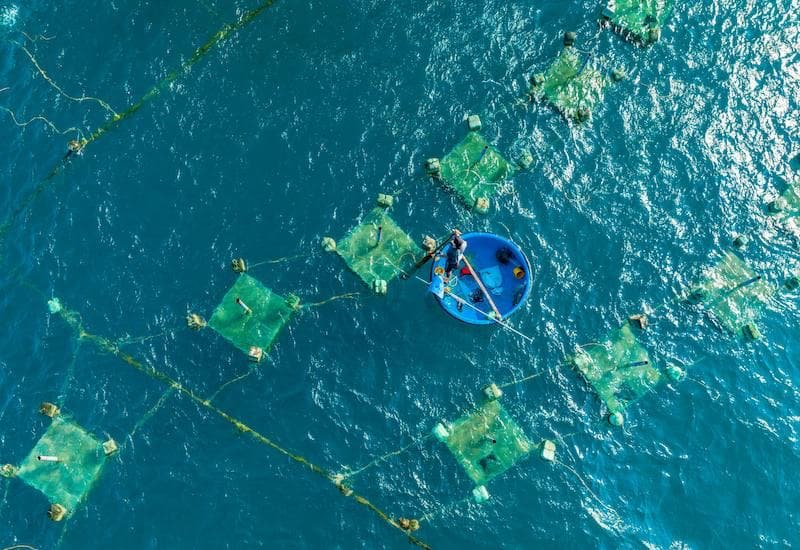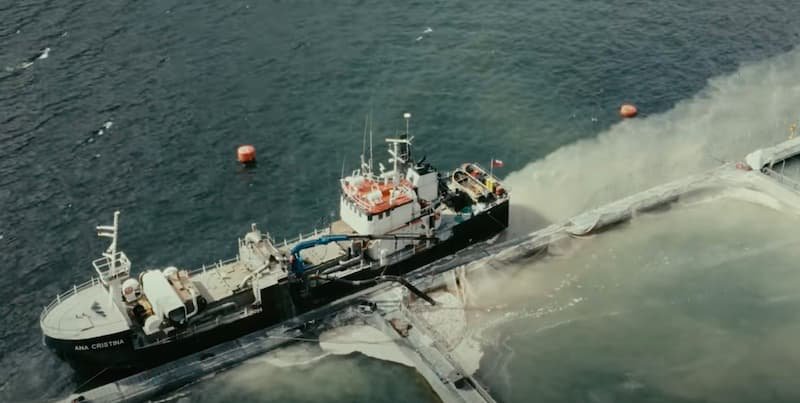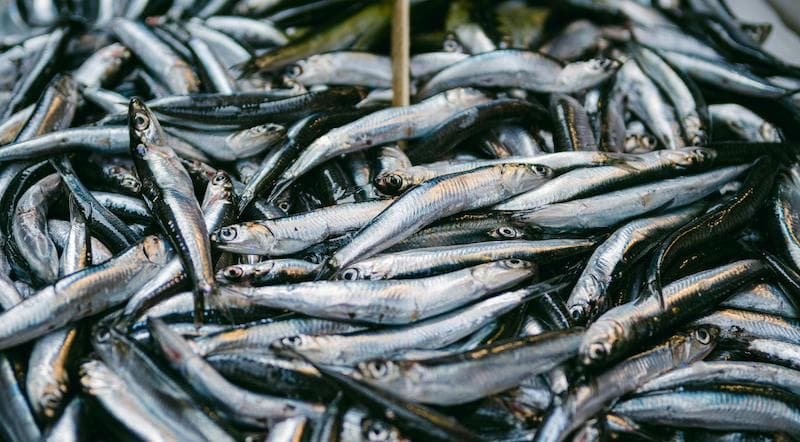
 Olivia Møller
Freediver - Activist - Explorer
Olivia Møller
Freediver - Activist - Explorer

 Olivia Møller
Freediver - Activist - Explorer
Olivia Møller
Freediver - Activist - Explorer
As the global appetite for seafood grows, traditional fishing methods struggle to meet demand sustainably. In response, fish farming, or aquaculture, has emerged as a critical player in the pursuit of a reliable and environmentally conscious seafood supply. In this exploration, we'll look into the advantages and drawbacks of fish farming and consider its potential evolution into a more eco-friendly alternative to traditional fishing.
Fish farming presents several advantages that contribute to its role as a pivotal player in addressing the growing demand for seafood. One of its foremost merits lies in its capacity to facilitate sustainable seafood production. By allowing for the controlled cultivation of fish, aquaculture significantly reduces the pressure exerted on wild fish populations, mitigating the risk of overexploitation and depletion of marine resources. This sustainability aspect aligns with the global imperative to preserve and restore the delicate balance of marine ecosystems.

Beyond its ecological contributions, fish farming serves as an economic catalyst, particularly in coastal communities. The industry provides a fertile ground for employment opportunities, fostering growth in regions heavily reliant on fisheries. As traditional fishing faces challenges, aquaculture emerges as a promising alternative, sustaining livelihoods and contributing to the economic resilience of these communities. This economic diversification is crucial in ensuring the prosperity of coastal regions and, consequently, the stability of global seafood supply chains.
Furthermore, fish farming plays a pivotal role in mitigating the adverse effects of overfishing. By creating controlled environments for fish cultivation, it acts as a strategic countermeasure to the dwindling fish stocks in natural fisheries. This proactive approach helps preserve biodiversity, maintain the delicate balance of marine ecosystems, and prevent the collapse of fisheries due to excessive exploitation.
In addition to its role in environmental conservation, fish farming offers a consistent and reliable supply of seafood throughout the year. Unlike traditional fishing, which is subject to seasonal variations and external factors, aquaculture ensures a steady production cycle. This dependable year-round availability not only meets the ever-growing consumer demand for seafood but also contributes to the stability and predictability of the market.

Another significant advantage lies in the customizable conditions that fish farming affords. Farmers can meticulously regulate factors such as water quality, temperature, and nutrition, optimizing these parameters to foster the health and growth of the cultivated fish. This level of control not only enhances the overall well-being of the farmed fish but also allows for more efficient and sustainable farming practices.
In essence, the pros of fish farming extend far beyond mere seafood production. From ecological sustainability and economic development to a consistent supply of seafood and customizable farming conditions, aquaculture emerges as a multifaceted solution to the challenges facing the traditional fishing industry. As the world grapples with the imperative to balance seafood consumption with environmental conservation, fish farming stands as a beacon of promise in achieving these intertwined goals.

Despite its merits, fish farming is not without its share of challenges, and an exploration of its drawbacks is essential for a comprehensive understanding of its impact. One prominent concern is the environmental impact associated with intensive fish farming. In these operations, the concentration of fish in confined spaces can lead to the accumulation of excess feed and waste, which, in turn, results in water pollution. The discharge of nutrient-rich effluents into surrounding water bodies can disrupt local ecosystems, triggering algal blooms and oxygen depletion, further exacerbating the environmental toll.

Disease transmission is another significant drawback of fish farming, particularly in high-density aquaculture systems. The close proximity of fish in farms creates an environment conducive to the rapid spread of diseases. To counteract this, farmers often resort to the use of antibiotics and other treatments, which can have adverse effects on both the cultivated fish and the surrounding aquatic environment. The unintended consequences of these disease management practices include the development of antibiotic-resistant strains and potential harm to non-target species.
Genetic concerns pose yet another challenge to the sustainability of fish farming. The concentration of fish in farms can lead to genetic homogeneity within populations, diminishing the overall genetic diversity of the species. This reduced genetic variability may render farmed fish more susceptible to diseases and environmental changes, compromising their ability to adapt and survive in the long term.
Escapes from fish farms represent a tangible threat to wild populations. When farmed fish breach containment, they can interbreed with wild counterparts, potentially diluting the genetic integrity of native species. This interbreeding can lead to unintended consequences, including reduced fitness and competitiveness in the wild populations, further contributing to the erosion of biodiversity.

Furthermore, the feed dependency of many farmed fish exacerbates the strain on marine ecosystems. Carnivorous species raised in aquaculture often rely on wild-caught fish as a primary component of their feed. This demand for forage fish, such as anchovies and sardines, contributes to overfishing of these species, disrupting the balance of marine food webs and cascading effects throughout the ecosystem.
In summary, while fish farming addresses the pressing need for sustainable seafood production, it is not without its ecological and biological challenges. Environmental impact, disease transmission, genetic concerns, escape events, and feed dependency collectively underscore the importance of ongoing research and the implementation of responsible farming practices to mitigate these cons and foster a truly sustainable aquaculture industry.

Recognizing the environmental challenges associated with fish farming, the industry is undergoing a transformative journey towards greater sustainability. This evolution is marked by innovative approaches and practices aimed at mitigating the ecological impact and fostering a more environmentally friendly model of aquaculture.
One notable advancement is the adoption of Integrated Multi-Trophic Aquaculture (IMTA). This holistic approach involves cultivating multiple species – such as fish, shellfish, and seaweeds – in proximity. By establishing a symbiotic relationship, where the waste produced by one species serves as nutrients for another, IMTA minimizes the environmental footprint of fish farming. This innovative technique not only reduces the discharge of pollutants into surrounding waters but also enhances resource efficiency and promotes a more balanced and resilient ecosystem.
Closed-loop systems represent another stride towards environmental sustainability in fish farming. These enclosed environments effectively prevent the escape of farmed fish into the wild, addressing concerns about interbreeding and the potential introduction of diseases to native populations. Closed systems also allow for precise control over water quality parameters, waste management, and disease prevention, creating a more controlled and environmentally friendly aquaculture setting.
A critical focus in the journey towards environmental friendliness is the development of alternative feeds. Traditionally, many farmed fish species are carnivorous and rely on wild-caught fish as a primary component of their diet. This practice contributes to overfishing and places additional strain on marine ecosystems. Ongoing research is dedicated to the creation of sustainable and plant-based alternatives to traditional fish feed. The goal is to reduce the industry's reliance on wild-caught fish, thereby lessening the impact on forage fish populations and promoting a more balanced marine ecosystem.

Selective breeding programs are also playing a crucial role in shaping the future of environmentally friendly fish farming. By focusing on traits such as disease resistance, growth rates, and overall fitness, these programs aim to develop fish populations that are not only healthier and more robust but also better adapted to the challenges presented by aquaculture environments. This approach contributes to the long-term sustainability of the industry by reducing the need for interventions like antibiotics and minimizing the risk of disease outbreaks.
Moreover, regulatory measures are emerging to enforce responsible farming practices and discourage environmentally harmful methods. Stringent certification processes, such as those provided by organizations like the Aquaculture Stewardship Council (ASC), encourage farmers to adhere to high environmental and social standards. Compliance with these standards not only enhances the industry's overall sustainability but also builds consumer confidence in the environmental integrity of farmed seafood.
In conclusion, the evolution towards environmental friendliness in fish farming is marked by a convergence of technological innovation, research initiatives, and regulatory frameworks. The adoption of practices like IMTA and closed-loop systems, the development of alternative feeds, selective breeding programs, and stringent regulations collectively signify a commitment to addressing and overcoming the environmental challenges associated with aquaculture. As these efforts continue to gain momentum, the vision of a more sustainable and ecologically harmonious fish farming industry comes closer to realization, offering a promising future for the responsible cultivation of seafood.